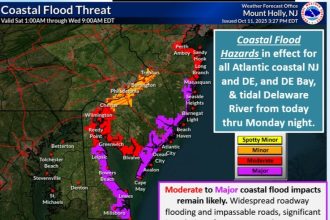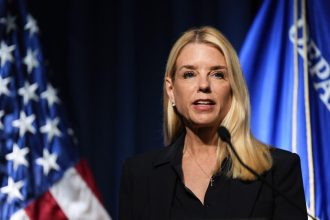The White House has tried to tune the ongoing government shutdown so that everyday Americans barely notice. That’s harder to do every day the government’s doors stay shut.
Though air traffic controllers are working, it wouldn’t take much for absences among their ranks to disrupt flights across the country. National parks are open but it/s uncertain for how much longer. The Trump administration is scrambling to continue to pay for troops, food programs for low-income women and children, Head Start and more.
White House spokesperson Abigail Jackson acknowledged the administration is “working to mitigate the negative impacts of the Democrat shutdown as much as possible, but we won’t be able to stop all the harm the Democrats are inflicting on the American people.” She added that “Democrats must stop their shutdown and reopen the government.” (Democrats insist that Republicans are to blame.)
The looming consequences of continued inaction could prove problematic for Republicans as they seek to shift responsibility for the shutdown to Democrats. Polls already show that Republicans are shouldering more of the blame than Democrats. Nearly 90 percent of Americans believe the shutdown is at least a “minor problem,” and more than half see it as a “major one,” according to an AP-NORC poll out last week.
And the longer the shutdown stretches on, the more cracks will form.
As in the past, air travel is mostly unaffected, though sporadic delays due to “staffing” have been seen across the airspace. Air traffic controllers, considered essential workers, are working without paychecks — though the administration is exploring ways to pay them to avoid cascading delays that could afflict travelers nationwide if just a few call in sick.
Last week, the Pentagon managed to pay troops despite the shutdown by shifting about $8 billion from its research and development accounts — but that’s a “temporary fix,” said Speaker Mike Johnson, who warned that service members would miss their next paychecks if the government is still shut down at the end of the month. Senators are now sparring over legislation that would pay active-duty troops and some federal workers, though until the House returns from its recess nothing Congress does can become law.
The administration has tried to keep WIC benefits for low-income women and infants flowing by using $300 million in unused tariff revenue earlier this month. But a top nonprofit organization said Tuesday the program would require an additional $300 million to keep it operating past November.
Although a handful of Head Start programs for low-income children and families were already affected when the shutdown began, another 134 programs are set to miss payments due to them on Nov. 1, according to the National Head Start Association.
And the Trump administration may soon have to change how it’s managing national parks, which are historically one of the more visible signs of a shutdown. Right now, national parks remain open and more functional than in the last shutdown, when waste and trash piled up fast. But it’s unclear how long that can continue, since that requires drawing from limited reserves that vary from park to park.
“We’re borrowing from Peter to pay Paul here, literally, because we gotta pull from non-appropriated funds like recreation fees to help keep the parks open, keep permitting going, keeping all the stuff going, to keep America going,” Interior Secretary Doug Burgum said last week in a radio interview.
The federal judiciary — including courts overseeing some cases brought against the Trump administration — is also seeing impacts after running out of funding to maintain the normal operations and work of roughly 30,000 staffers, two support agencies, 13 regional appeals courts and 94 district courts. Some courts are furloughing staff for the first time in three decades, requiring others to work without pay, and even operating under a limited, four-day-a-week schedule.
And that could get worse the longer the shutdown continues.
In addition, the more the Trump administration attempts novel ways to paper over the shutdown’s effects by shuffling around money, the more chance there is that those actions could draw legal challenges or fines. Shifting funds without an act of Congress is banned by the Antideficiency Act, a more than 150-year-old law enacted to prevent federal agencies from spending money Congress hasn’t appropriated.
During the last prolonged shutdown, a 35-day slog during Trump’s first term, the Government Accountability Office determined the administration had violated the law by tapping recreation fees to keep national parks open and also by making SNAP payments early — and threatened that if officials continued, they could be arrested and fined.
For now, the White House is mostly focused on convincing Americans that the shutdown, such as they realize it exists, is Democrats’ fault.
Veterans Affairs Secretary Doug Collins on Wednesday sent a letter to Senate Minority Leader Chuck Schumer bashing him for continuing a shutdown that “threatens to erode the trust of America’s more than 17 million Veterans who may question the Government’s commitment to those who have served.”
“As this shutdown continues into a third week, its disruptive effects are increasingly evident,” Collins wrote.
The Homeland Security Department has ordered a video to be played at all airport checkpoints featuring Homeland Security Secretary Kristi Noem blaming congressional Democrats for making Transportation Security Administration agents work without pay. (Some airports, however, have refused to play the video because it contains political messaging.)
Several agency websites display popup messages bashing the “Democrat shutdown,” and some staffers’ out of office responses include overtly political messaging. And Trump has made escalating threats to use the shutdown as an “opportunity” to go after Democrats, which so far has included billions of dollars in cuts to infrastructure projects in blue states.
The White House is also using the shutdown to further cull the federal workforce through mass layoffs that specifically target programs, projects and activities that are “not consistent” with Trump’s priorities. Reduction in force notices went out to about 4,000 federal workers earlier this month, according to court filings, and budget director Russ Vought last week projected “north of 10,000” total layoffs. A federal judge has blocked the RIFs.
Heather Richards contributed to this report.









